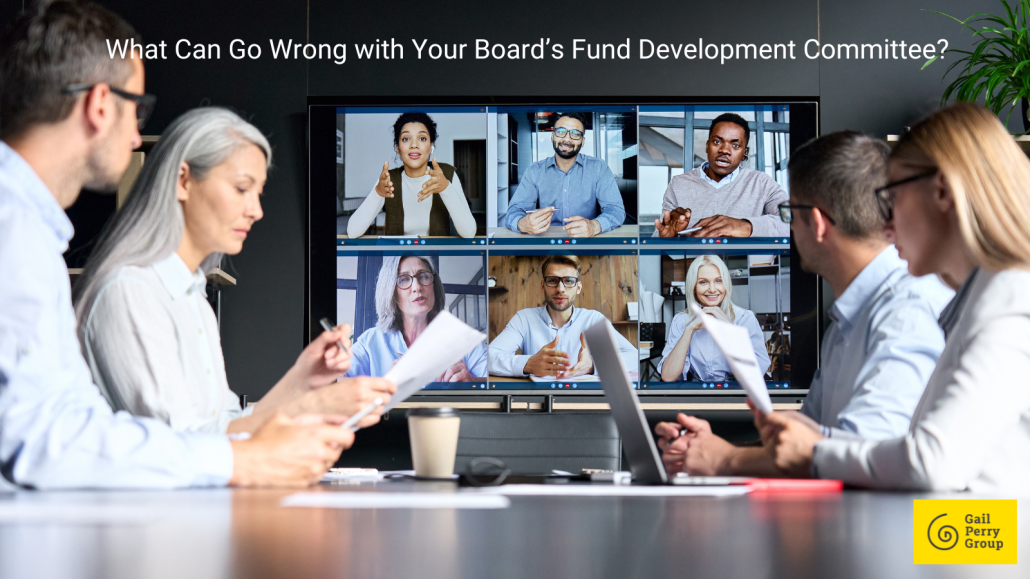What Can Go Wrong with the Board’s Fund Development Committee?

What’s the best role for the board Fund Development Committee?
In the nonprofit world, most organizations set up a Fund Development Committee that helps to focus the board’s fundraising efforts.
Who does what?
In very small organizations with no professional staff, board members often literally do the work of fundraising. They serve as “on the ground fundraising representatives,” working hard to help their organizations raise money.
When an organization reaches the size where it can hire fundraising professionals, the role of board members and executive directors frequently shifts.
What’s the role of the professional fundraising staff?
The well-trained and experienced fundraising team now creates and executes fundraising strategy for the organization.
The fundraising staff serves as “team leader” for overall fundraising efforts, as they create a fundraising plan. They mobilize the board and ED to take specific actions to help execute the annual fundraising plan.
Receive expert advice. Direct to your inbox. Subscribe
Board members and ED’s typically take their direction from the fundraising team, heading out in the community as ambassadors, opening doors to new donors and key stakeholders and engaging in donor relations.
So, what can go wrong?
There is often confusion about the appropriate role of the board Fund Development Committee.
Sometimes, if things go wrong, the committee format creates a perfect opportunity for undue interference with the annual fundraising plan.
What’s worse, the committee creates an opportunity for a group of well-meaning but inexperienced volunteers who try to actively set fundraising strategy.
Please remember: We love and appreciate our board members! They are dedicated, passionate supporters who give of their time and resources to help our organizations as best they can. We’re grateful for their thoughtful advice and strategic guidance.
However, we need to leave fundraising strategy to the trained professionals. That’s what you hired them for – their expertise.
Here are five ways the Fund Development Committee structure can get it wrong:
1. Confuses roles and responsibilities.
Who is authorized to set fundraising strategy? Who is supposed to make decisions about how staff uses their time? It’s the Executive Director’s role here, not the board’s.
Find out how we can help you achieve your fundraising goals with world-class consulting and custom training.
Unfortunately, the Fund Development Committee can all too often be a vehicle for board members to interfere in fundraising strategy and policy.
What happens in these cases, is that committee members start offering their personal opinions and preferences as they try to influence the fundraising program.
Above all, the Board should not set fundraising strategy or make decisions on specific fundraising initiatives. These individuals frequently do not understand how fundraising works today.
This is the role of the professional staff, who should know what they are doing.
Fundraising is now a well-researched body of work. Staffers get professional training to do their jobs. They know how to do it best.
2. Opens the door to micromanaging internal affairs.
Above all, board members should not be seeking to influence specific fundraising strategies or tactics.
Once I served on a board that was having an open discussion about its fundraising plan. One of the board members started emotionally and vociferously trashing digital fundraising.
Why? Because, in her mind, no one ever read emails. This lady well was on her way to directly influencing fundraising strategy, because she was loud and passionate. (Often the loudest voice in the room sways the rest!)
I was taken aback, literally speechless that this was happening!
Fortunately, another board member piped up quickly. She said, “the reason people send digital appeals, is because they WORK!”
3. Can be insulting to professional staffers.
Because the Fund Development Committee creates an opening for board members to evaluate and manage the fundraising program, things can get awkward.
We’ve seen board members offer their personal opinions about the fundraising program directly to the professional staff, who are obliged to take them seriously. Remember the power imbalance here.
In over 30 years in this business, we have seen ageism, sexism, and other isms at play in the relationship of board members to staffers.
The power imbalance is huge. Not only is it uncomfortable – it’s demoralizing.
I’ve seen successful business executives talk down to younger female staffers with a know-it-all patronizing attitude. There can be a lack of respect to staff, coupled with an attitude of “We know more than you do.”
Can you imagine a board member strongly suggest that the staff sell $15 coupon booklets as a fundraising strategy? It happened here in our back yard.
When this happens, the board members are completely out of line, with no referee to stop them.
When we are in an environment where dissatisfied fundraising staffers are leaving their jobs all over the world, then the last thing we want is to make them feel uncomfortable.
Instead fundraisers need praise, acknowledgment and support from their loyal board members.
4. Negates the authority of the CEO.
This kind of direct interference in operations, breaks the inviolate rule that board members do not directly ask staff to do things or take on additional projects.
Instead, board members are supposed to deal only with the CEO, who employs and directs the staff.
When board members are authorized (by virtue of the committee) to offer their (uneducated) opinions about fundraising and expect to be taken seriously, it undercuts the entire professional staff structure.
5. Promotes decision making without enough information or context to make good decisions.
This is an overriding issue with many nonprofit boards, who sometimes can rush key decision-making without thoughtful deliberation or background information.
Unfortunately, they don’t know the context, or the strategic implications of the decisions they are making, because they have not been well-informed.
For example, enthusiastic board members may want a specific type of fundraising event, or gala and it is one that requires significant staff support.
However, they do not see the whole picture. They don’t realize that their limited staff is fully committed to other activities.
If this board insists on this event, then the staff has two choices, they can drop their previous plan (which means important fundraising activities such as grant proposals, direct mail and digital strategies, donor engagement events) have to be postponed.
Bottom line on Problems with the Board’s Fund Development Committee.
This issue is happening in many places, everywhere. To prevent it, make sure the board understands its role. Do not leave it to chance.
It’s important for everyone involved to know who has responsibility for what, and to stay in their appropriate lanes of traffic.
Then, you can have a successful organization and a high-performing board and staff who work respectfully together.
If your organization is planning a capital campaign or expanding your major gifts program – we can help. Email coaching@gailperry.com if you’d like to schedule a free strategy call with us.



